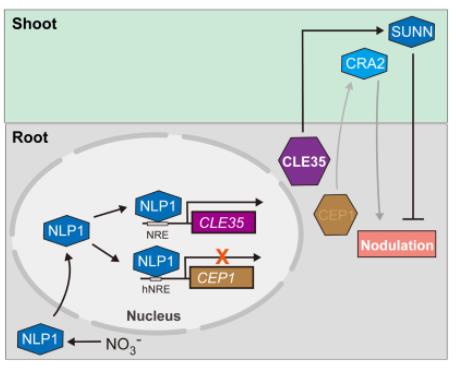How to repress legume symbiotic nodulation in response to nitrate
NLP1 binds the CEP1 signaling peptide promoter to repress its expression in response to nitrate
Nitrate is an essential macronutrient for plant growth and development, which also acts as a molecular signal to regulate gene expression and root system architecture. As plants cannot choose their environment but have to adapt, they have evolved sophisticated strategies for nitrogen (N) acquisition in relation to sources availability, to optimize plant growth in response to fluctuating external nutrient supplies. Regulatory mechanisms for nitrate acquisition comprise both local and systemic long-distance signaling pathways that inform on the intrinsic nutritional status of the whole plant. Legume plants can symbiotically associate with rhizobia soil bacteria to form root nodules and fix atmospheric N2 for the benefit of the host plant. This is however an energy-consuming process that is thus inhibited by the presence of mineral N in soils, eg nitrate. Studies in the model legume Medicago truncatula revealed that the NIN (Nodule Inception)-like proteins NLP1 and NLP4 are critical for the nitrate inhibition of nodulation. Indeed, in a recent study, the SILEG team from IPS2 showed that NLP1 promotes in the presence of nitrate the expression of the CLE35 signaling peptide to inhibit systemically nodulation, through a direct binding of its promoter on Nitrate Responsive cis-Elements (NREs). In this new study performed in collaboration with Dr. Fang Xie’s laboratory (Shanghai, China) and published in New Phytologist, we showed using different complementary approaches that MtNLP1 binds the promoter of another type of signalling peptide acting under N deficiency, the C-terminally Encoded Peptide MtCEP1, to repress its expression in the presence of nitrate through specific half NRE (hNRE) motifs.

In response to nitrate, the NLP1 transcription factor not only directly induces the expression of the CLE35 signaling peptide that inhibits symbiotic nodulation, but also directly represses the expression of the MtCEP1 signaling peptide to inhibit its nodulation promoting activity.
NLP1, NIN-Like protein 1 transcription factor; NRE, Nitrate Responsive cis-Element, hNRE, half NRE; CLE35, Clavata-Like 35 signaling peptide; CEP1, C-terminally Encoded Peptide 1; SUNN, Super Numeric Nodules receptor; CRA2 Compact Root Architecture 2 receptor.
Le 28/03/2022
